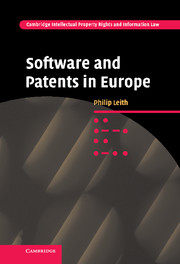Book contents
- Frontmatter
- Contents
- List of figures
- Introduction
- 1 Software as machine
- 2 Software as software
- 3 Policy arguments
- 4 Software patent examination
- 5 Holding the line: algorithms, business methods and other computing ogres
- 6 The third way: between patent and copyright?
- 7 Conclusion: dealing with and harmonising ‘radical’ technologies
- Index
- Cambridge Intellectual Property and Information Law
6 - The third way: between patent and copyright?
Published online by Cambridge University Press: 22 July 2009
- Frontmatter
- Contents
- List of figures
- Introduction
- 1 Software as machine
- 2 Software as software
- 3 Policy arguments
- 4 Software patent examination
- 5 Holding the line: algorithms, business methods and other computing ogres
- 6 The third way: between patent and copyright?
- 7 Conclusion: dealing with and harmonising ‘radical’ technologies
- Index
- Cambridge Intellectual Property and Information Law
Summary
The patent system is essentially weak and vulnerable even in the more industrialised of modern societies, but it does confer some advantages, as we have shown, and it is an important protection for the small firm and the small man. On balance it is a valuable institution, but its economic value overall is quite modest, and it is desirable that extravagant claims should not be made on its behalf.
Introduction
The thrust of this text has been a mild defence of software patenting, primarily suggesting that:
A new technology should be viewed as a technology on its own merits rather than via the legal fiction that it is something else.
If invention in technology is to be protected as a social good, then why should invention in software technology not be so similarly protected? It is surely as difficult to invent in the programmed sphere as in any other.
Arising from a form of ‘technological determinism’, even if we are against software protection, there is – in the longer term – little which can be done to prevent it: since even if one does not agree with the pro-patenting perspective the fact that the malleability of software and its ability to undertake a ‘machine-like’ transformation in parallel to its taking over the role of the machine task (that is, from analogue control to digital control) quickly meant that it was near impossible (in terms of overall coherence of the system) to prevent patent applications from dressing themselves in the required format and gaining protection.
- Type
- Chapter
- Information
- Software and Patents in Europe , pp. 156 - 181Publisher: Cambridge University PressPrint publication year: 2007



